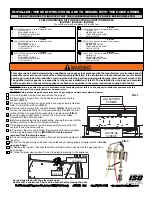
INSTALLER’S GUIDE
Page 4
CONTENTS
SAFETY ...............................................................................................................................................3
1 APPLIANCE DATA..........................................................................................................................5
2 GENERAL INSTALLATION REQUIREMENTS...............................................................................6
3 PACK CONTENTS ........................................................................................................................12
4 FIREPLACE CHECK .....................................................................................................................15
5 IGNITION CHECK..........................................................................................................................17
6 GAS SUPPLY CONNECTION .......................................................................................................18
7 PREPARING APPLIANCE FOR INSTALLATION.........................................................................19
8 HOTBOX INSTALLATION.............................................................................................................21
8.1 Method 1 - Front Fixing to Fireplace Surround .................................................... 21
8.2 Method 2 - Cable Retention and Floor Fixing....................................................... 22
8.3 Sealing Floor Front - All installations ................................................................... 24
9 BURNER & SUPPLY PIPE INSTALLATION.................................................................................25
10 CERAMIC WALLS INSTALLATION.............................................................................................27
11FRONT SURROUND & CONTROL LINKAGE INSTALLATION...................................................28
12CERAMIC COALS INSTALLATION..............................................................................................30
13FRONT / CASTINGS INSTALLATION ..........................................................................................34
14FULL OPERATING CHECKS........................................................................................................35
14.1Check the Control Settings .................................................................................... 35
14.2Check For Spillage................................................................................................. 36
14.3Flame Supervision & Spillage Monitoring System............................................... 36
15FINAL REVIEW..............................................................................................................................38
16SERVICING & PARTS REPLACEMENT.......................................................................................39
16.1Checking the aeration setting of the burner........................................................... 39
16.2To Remove the Ignition Microswitch.................................................................... 40
16.3To Remove the Gas Shut-Off Microswitch........................................................... 41
16.4To Remove the Fire Front Surround...................................................................... 41
16.5To Replace the Control Slide Unit ........................................................................ 42
16.6To Replace the Control Slide Button..................................................................... 42
16.7To Remove the Burner Unit .................................................................................. 42
16.8To Remove the Electronic Ignition Generator ...................................................... 42
16.9To Remove the Thermocouple Interrupter Block ................................................. 43
16.10 To Remove the Pilot Unit ................................................................................... 44
16.11 To Remove the Shut-Off Tap.............................................................................. 45
16.12 To Remove the Gas Flow Rate Controller.......................................................... 46
16.13 To Remove the Main Burner Injector................................................................. 46
16.14 To Replace Burner Plaques................................................................................. 48
16.15 To Remove the Appliance from the Fireplace.................................................... 49
17SHORT LIST OF SPARES ............................................................................................................50





































